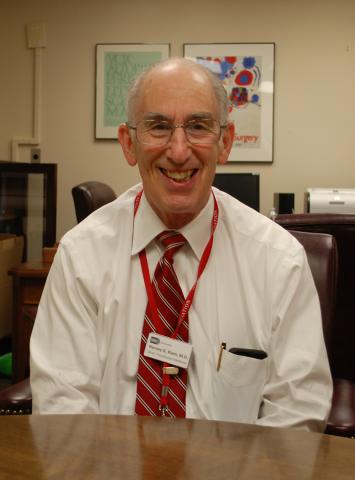Klein, Titan of Blood Bank, Retires After Long NIH Career

Photo: Rich McManus
Dr. Harvey Klein, chief of the Clinical Center’s department of transfusion medicine (DTM) for the past 36 years and a stalwart of hematology research at NIH for 46 years, retired on Sept. 30. He has accepted scientist emeritus status and plans to mentor young recruits in retirement.
“I think you know when it’s time,” he said, “and it’s time.”
Klein arrived at what was then the National Heart and Lung Institute in 1973 as a “Yellow Beret,” or individual who opted for “obligated service” as a member of the PHS Commissioned Corps rather than serve in the military during the Vietnam War. A native of Boston, he was a graduate of Harvard College and got his M.D. at Johns Hopkins University, where he was involved in the first dozen bone marrow transplantations undertaken at its hospital.
Assigned to the heart institute’s newly formed Blood Division, he came to what was then the NIH Blood Bank for a year to work with scientists there and ended up staying for 9 years as its deputy chief. In 1983, he was named DTM chief, taking over an operation that “increased logarithmically over the years” from 27 employees in 1975 to more than 200 today.
“There was no apheresis [separation of one component of blood, then return of the remainder to circulation] at all back then, neither for blood components or therapeutics,” Klein recalls. “There was no HLA [blood-typing] lab in the Clinical Center or the blood bank. There was no such thing as cell processing of any kind back then. We were the first group in the country to collect platelets by apheresis entirely. Now, virtually all blood banks in the country use apheresis.”
Most prominently, DTM now runs the Center for Cellular Engineering, a burgeoning enterprise that hosts the department’s former special services laboratory (designed in the mid-1980s to process bone marrow for eventual transplantation; the lab later evolved into the cell processing section, which put the first genes into cells for the world’s first cellular gene therapy) in a new building currently going up on the Clinical Center’s east side, in addition to lab space on two wings of the hospital.
“The center has more than 30 protocols for making different kinds of cells,” said Klein. “Retinal pigment epithelial cells, for NEI, CAR T-cells for NCI, stem cells, for bone marrow transplantation. We are doing very exciting kinds of things in cancer, immune deficiency diseases, chronic granulomatous disease and gene therapy, where we insert vectors into hematopoietic cells. The center has grown by leaps and bounds.
“[Engineered cells] is one of the most exciting developments in transfusion medicine today,” Klein continued. “I am going to miss the excitement, and the people for sure. It’s been wonderful. It has been not only a pleasure, but also an honor to be part of the NIH Intramural Research Program over the years.”
Klein, DTM’s fourth and longest-serving chief, also credits a long roster of CC directors, “all of whom have been just enormously supportive of this department.”
Dr. John Gallin, director of the Clinical Center from 1994 to 2016, said, “Dr. Klein was not only a fabulous chief of transfusion medicine but also was a special advisor on all issues related to hospital function and the clinical research environment. He was a great colleague and friend and we will miss him greatly. But we are happy he will remain as an advisor in emeritus status.”
Klein almost left NIH in 1998, when he retired after 25 years from the Commissioned Corps. “I had planned to leave for academia, and I had an offer from Harvard,” his alma mater, in his home town. “It’s unusual to go from the corps to [federal civilian employment]. And it was a tough offer to turn down—my mom would have turned over in her grave. But I never looked back, and I never regretted it. NIH is a great place to do clinical research.”
Klein presided over a number of other significant firsts, including DTM’s founding membership in the National Donor Marrow Program, which enrolled some 20,000 HLA-matched donors; he served on NMDP’s standards committee and board. Klein is also a founding member of the American Society for Apheresis, which was established in fall 1979.
Taking seriously the evidence for the benefits of exercise, he was among the four founding members of the NIH jogging club.
“Allen Lewis, Rick Davey and I from the Blood Bank, and Dave Young from NCI founded the NIH jogging club as Health’s Angels in 1976,” said Klein. “Linda Brown of Medical Arts designed the logo, a rabbit with a halo—I have one of the original T-shirts.”
A veteran of the Boston Marathon (best time, 3:12), Klein, once a fixture along Cedar Lane and the Rock Creek bike path, where he took 8- to 10-mile runs in the mornings before work, quit running “only in the past 3 years. I just cleared out my locker here. I miss it. I miss it a lot.”
Still committed to physical fitness, he now pursues elliptical training, rowing and walks on the C&O Canal, which abuts his home in Potomac, just south of Pennyfield Lock.
“My blood pressure goes down 10 points as soon as I turn in my driveway,” he said.
A search for DTM chief is now underway. Serving as acting chief is Dr. Cathy Cantilena, a long-time Clinical Center veteran whom Klein says is deeply familiar with every aspect of the department’s activities.
